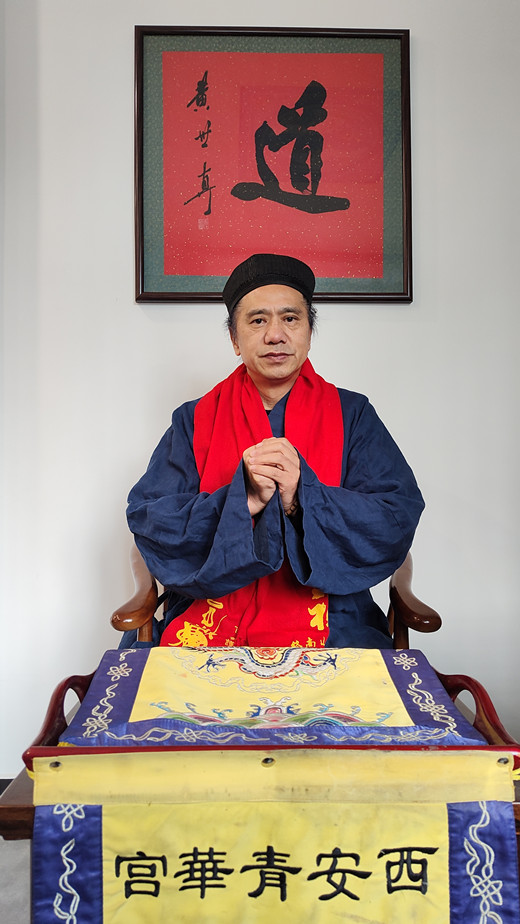道教思想五论——关于道教教义现代阐释的思考(2)
道教之音 张继禹
2012-12-14
道教历代宗师都倡导“贵生”、“重生”和“生道合一”的思想。老子讲深根固蒂,是达成长生久视的方法;谷神不死,意味着长生可期。庄子认为神仙是一种理想的人格存在形式,人修身可以长生,成为神仙。南北朝高道陶弘景在《养性延命录》中云:“夫禀气含灵,惟人为贵。人所贵者,盖贵于生,生者神之本,形者神之具。” 认为天地间一切生命存在形式中,以人为贵。因为人的生命形式本身就体现了神之属性,神是道的载体,故人的生命形式的存在也体现了道的存在。唐代高道司马承祯《坐忘论》认为:人最宝贵的是自己的生命,因为生命是道的体现。人与道的关系,就好比鱼和水的关系,鱼离水则死,人失道亦不能生。所以,道教特别重视养生、摄生,而养生、摄生的最重要目的在于体道。生命的存在是道的体现,生与道可以相保。
The Daoist discourse on life is of long standing. Laozi advocated “making one’s roots firm” as a way of extending life and his reference to the deathlessness of the spirit of the valley hints that one can extend life through cultivation practices. As the 6th century Daoist Tao Hongjing wrote in his Records on Nurturing the Inborn Nature to Extend Life “Of all beings blessed with qi and spirit, humans are most valued. And that which humans value is life. Life is the root of the bodily spirits and the body is the tool of the spirits.” Since spirits are bearers of the Dao, human life gives concrete form to the Dao. The Tang Daoist Sima Chengzhen points out that the human relation to the Dao is like that of fish to water. We move within it, it moves through us, and without it, we die.
同时,道教认为,人的生命并不取决于天命,而是可以掌握在人自己手中。早期道教经典《太平经》称:“天道万端,在人可为。”“天道”就其内容而言是非常丰富的,可谓是“万端”,但是人可以认识和运用“万端”的“天道”。东晋高道葛洪在《抱朴子•黄白》引《龟甲文》明确表示:“我命在我不在天,还丹成金亿万年。”认为人可以主宰自己的命运,可以通过修炼和服饵,使自己的生命达至长久。
道教“重生”、“贵生”、“生道合一”的思想对于当代社会来说,亦有其重要意义,对于现代人如何养生、乐生,保持身心健康具有重要的参考价值。
At the same time, Daoists do not believe that human fate is determined by heaven. Instead, one can take one’s fate into one’s own hands. The early Scripture of Great Peace states “the Dao of heaven moves in multiple directions, and humans are able to make use of it.” And the 4th century Daoist Ge Hong stated the matter forthrightly: “My fate lies with me, not with heaven.” Ge believed that by psychophysical cultivation and the ingestion of herbs one could lengthen one’s life. Traditional Daoist views on the importance and sanctity of life help us today in our efforts to cultivate the health of the individual and society.
四、道术体用论 The Dao and Technique as substance and utility
前文已论述过,道教重生、贵生。在道教长期的发展过程中,众多道门中人围绕着仙道与贵生、金丹与长生、修道与养生等课题,进行了不懈的探究与实践,形成了完整的理论体系与丰富的修证方法。这种种道教修炼的方式方法统称为“术”,而道教精神的实质,则可称为“道”。 自古以来,道教修炼具有既重“道”又重“术”的传统。道经中说:“道者,灵通之至真。术者,变化之玄技也。道无形,因术以济人;人有灵,因修而会道。”道与术是相辅相成、互相对待的,两者并重,方可成就大道。但我们发现,在学习道教、信仰道教的过程中,很多人过于注重对术的研究,甚至是只注重术,而忽视了道。实际上,前人对此早已做过深刻的论述。道以术为用,术以道为体。二者互含互摄、相须而行,方能得道。这就是“道术体用论”。
Generations of Daoists have, based on the doctrines that we have discussed, tirelessly practiced and experimented so as to develop a theoretical system of self-cultivation practices. The Dao is the spiritual substance of Daoism and this system of practices is called by the general term “techniques.” As one Daoist text puts it “Since the Dao is formless, techniques are the means by which it saves human beings. Since humans are spiritual, through the cultivation of techniques they can join with the Dao.” In this way the Dao and its techniques are interdependent and equally valuable. But we have noticed that those who study Daoism tend often to place too much emphasis on techniques, sometimes to the extent of ignoring the Dao. The ancients noticed this problem long ago and thus developed the doctrine that the Dao takes techniques for their utility, while techniques take the Dao as the substance. This is what I mean by my discourse on the substance and utility of the Dao and its Techniques.
广成先生杜光庭在《仙传拾遗》中谈到这个问题:“术之与道,相须而行。道非术无以自致,术非道无以延长。若得术而不得道,亦如欲适万里而足不行也。”“道”隐藏在无名的玄妙之域,正是凭借着各种方术才得以彰显出来。“术”虽然有形可见,但需要依靠“大道”作为长存的根基。著名学者卢国龙先生用更加深入浅出的语言描述了道与术的关系,他说:道教本身的文化结构里就有两个层面,就一个是道的层面,一个是术的层面。道的层面是道教之所以成为一门宗教的立身之本,也就是它形而上的精神追求。还有一个是术的层面,术其实并不是指巫术,道教的术是实现其信仰,继承其教育的方式方法,包括养生术。养生术包含很多,比如内丹、外丹、服食、导引。但是,如果广义的来讲,就道教在不同的历史时期、不同的社会背景下,谋求它自身发展所采取的那些措施,广义而言其实那也是术。我们说的是通过这一系列的术背后,道教还有一个道,如果没有这个道,道教不成其为道教,那就只是一个方术的积累了。
On this subject, the 10th century Daoist Du Guangting wrote “Techniques must follow the Dao. Without techniques, the Dao has no way to manifest itself and techniques without the Dao cannot endure. Just mastering techniques without achieving the Dao is like trying to walk ten thousand miles without moving your feet.” Hidden in the realms of mystery and wonder, the Dao is made manifest precisely through techniques, but techniques require a foundation in the Dao to extend human life. The modern scholar Lu Guolong points out that the spiritual and metaphysical pursuit of the Dao is what makes Daoism a religion. Techniques are the realization of Daoist belief, heritors of its educational endeavors, and include the nurture of life in all its forms. These include alchemy and inner alchemy, diet, breath practice, stretches, etc. But, considered widely, all of the ways Daoism has responded to historical and social change throughout history can be called “technique.”
五、道俗圆融论。The perfect integration of the Dao with the secular.
道俗圆融的问题,涉及宗教的神圣性与世俗化的关系,这也是各大宗教都不可回避的老问题。那么,道教认为神圣与世俗是一种什么样的关系呢?这也是当代中国道教应该深入思考的问题。
The question of the integration of the Dao with the mundane involves the possibilities of religious sanctity within a secular society. This is a perennial question for religion. So, how does this work for Daoism?
在道教看来,不管是世俗的人性,还是神灵所具有的神圣性,均是“道”性的显现。但是,由于人类无止境的追求物质需要的满足,导致了人性的异化。异化的人性中,虽然恶的成份遮掩了本真的善性,但本真的善性并不因此而不存在。道教认为,去除异化之后,人性便可以与道性的神圣性相合。
From the Daoist perspective, all humans emanate Dao-nature, whether they are members of secular society or possessed of spiritual holiness. But, since people relentlessly seek the satisfaction of material desires, their natures are often perverted. Yet, even though evil elements might obscure their original good nature that does not mean this good nature does not exist. Daoism holds that people can reconnect with holy Dao-nature within themselves by discarding the perverting forces.
可见,人性与神性并不是对立的,人当努力向善,恢复自己的本真性。神性之所以是神圣的,乃在于它是永恒的、最完善的、最美好的。世俗的人性之所以被看作是不完善的,乃在于其与“道”的神圣性相背离。道教认为,通过道教的修持,可以提供人性复归之路,神圣在世俗中可以得到圆融。世俗性本身可以体现、映鉴出道的神圣性;通过对道的修持,世俗性可以将蕴含于自身中的“道”的神圣性澄明出来。这就是道教的“道俗圆融”论。
道俗圆融论主要解决的是道教出世的神仙追求与入世济世的生活态度和社会责任感的矛盾问题,以及现代人如何在生活中修道的问题等。
From this we see that human nature and divine nature are not opposites. The reason divine nature is seen as holy is that it is eternal, perfectly good, and perfectly formed. The reason human nature lacks holiness is because of its separation from the Dao. Daoists believe that, through self cultivation, there is a way for humans to return to the Dao. Through Daoist practice, the mundane human body can indeed reflect the divine and holy nature of the Dao. The Dao-nature within can be made manifest. The integration of the Dao with the mundane revolves around a contradiction: On the one hand Daoist separate themselves from the world to pursue transcendence while, on the other hand, they go into the world to save society.
道教是来源于民间的宗教,它是在老百姓最需要它的时候应运而生的,所以它在宣扬出世精神的同时,也洋溢着积极的入世情怀,主动关心社会、关爱他人。道教的入世情怀和济世功德,都建立在其教义思想的基础上,宗旨在于以入世的态度达到济世度世之目标,阐扬大道以裨益社会人群,裨益世教。
Daoism grew out of popular Chinese religion and in response to the needs of the people, so at the same time it preaches an otherworldly spirit, it enthusiastically espouses an attitude of worldly engagement, social concern, and love of others. This attitude finds its source in the doctrines of Daoism. We spread the doctrines of Daoism to aid human society and the world.
自入世以求济世,尽管不无世俗化的种种形态,但其根本旨趣却超越于一般世俗生活,是要对世俗生活进行升华。就这一点而言,道教亦非常强调超越性。但这种超越性并不意味着神圣之道与世俗社会是两不相干的,道教之所以在世俗社会中传道、进行教化,其实是其背负着伟大的宗教理想以推进社会发展的一种表现。因此,宗教所普遍具有的神圣性与世俗化的矛盾,反映在道教中,即是如何将入世济世与神仙超越统一起来;如何依据于道教的教义特质、因应时俗变化以调整行教方式的精神,即道经所谓“随方设教”。通过对这个问题的思考,可以体现出道教的济世利人的大乘精神,也可以为我们当代道教的发展提供某种有益的启示,找到道教在现代社会的生长点。
Through going out into this world in such an unworldly way, we aim to transcend society and thereby work for its perfection. The transcendence Daoists promote is really not a flight from society. In fact, when we expound the Dao in mundane society, we are propagating the highest of religious ideals to advance society. We thus seek ways to resolve the contradiction between spiritual holiness and the mundane world while remaining faithful to the special characteristics of Daoism and the particularities of social change. Through proper consideration of these forces we can not only meet the universalistic emphases of Daoist salvation, but also find within these the special qualities of Daoism appropriate to the current age.
面对入世济世与成仙证道构成的矛盾,《道德经》中关于可道与常道、《度人经》中关于度己与度人的辩证论述,道家的超然物我的思想智慧和神仙自由逍遥理想,为道教解决这一矛盾奠定了理论基础。在这样的教义思想指导下,务道之士一方面入世以济世度人,广行善举,关爱社会人群,以己之力利济他人,奉献社会,成就社会,积功累德;一方面修炼自我,遁居修仙,炼性炼命,以度己度人。这样便使入世与超越这一矛盾在一个更高的层面上得到了统一。
We have a number of historical precedents for our endeavor to resolve the contradiction between otherworldly and this-worldly pursuits: We find these in the Dao that can be spoken and the eternal Dao of the Daode jing; in the dual promotion of self-salvation and the salvation of others in the Scripture of Salvation; and in the distinction between the material self and the ideal of free-roaming in philosophical Daoism. The resolution takes place at a higher level, where the individual practitioner at once enters the world to save others, promoting morality, caring for society, and expending his or her energy for others and, at the same time, perfects the self, retires to pursue transcendence, and refines his or her nature to save self and others.
六、结语。Conclusion
以上五个方面虽然看似各自相对独立,但却又是相互联系的。道神一元论是核心和根本,道物依成、生道合一与道术体用是依据和津梁,而道俗圆融则是目标。通过这五论,旨在梳理出道教教义的核心和基本精神并作出新的阐释,为道教教义思想的现代建构作出一些探索。
Though the above five points appear independent, they are in fact interrelated. The shared nature of the Dao and spirits are the basis. The interdependence of the Dao and things, the unity of the Dao with life, and the status of the Dao and techniques as substance and utility – all depend upon it. Finally, the integration of the spiritual Dao within mundane society is the goal. Through a careful consideration of these five principles, we might construct a new explanation of the essential spirit of traditional Daoism and thereby reconfigure Daoist doctrine for the modern world.
此论文为中国道教协会副会长张继禹道长于2012年11月中旬应美国亚利桑那州立大学邀请,访问该校时所作的演讲
English summary by Stephen R. Bokenkamp (柏夷)


 |
|










 京公网安备 11010202006208号
京公网安备 11010202006208号